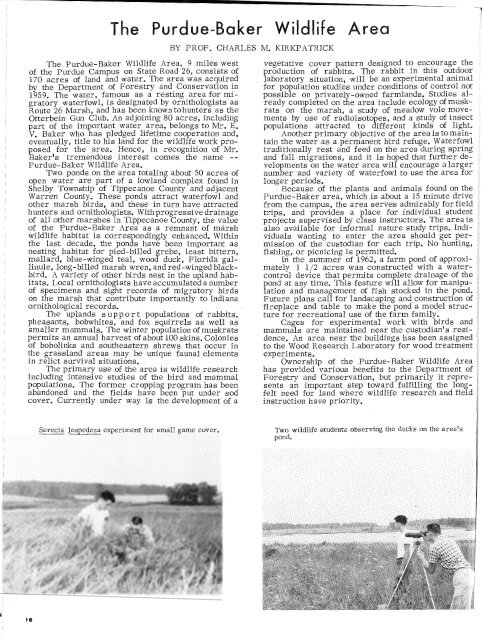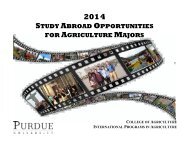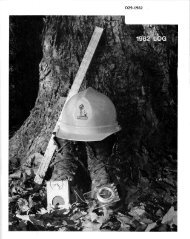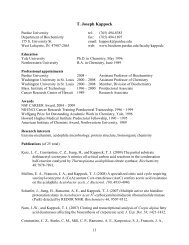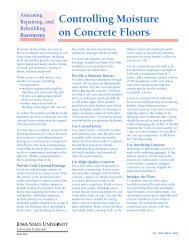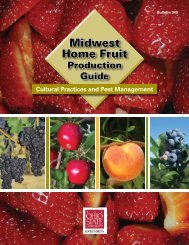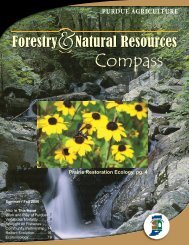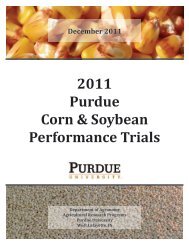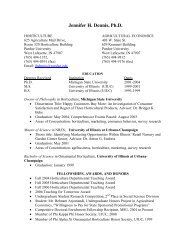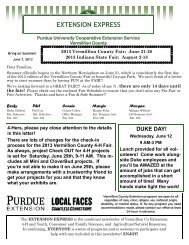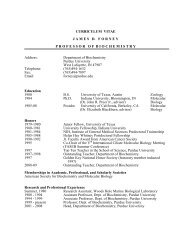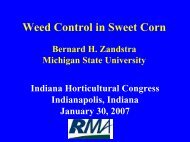1963 - Purdue Agriculture - Purdue University
1963 - Purdue Agriculture - Purdue University
1963 - Purdue Agriculture - Purdue University
- No tags were found...
You also want an ePaper? Increase the reach of your titles
YUMPU automatically turns print PDFs into web optimized ePapers that Google loves.
The <strong>Purdue</strong>-Baker Wildlife AreaThe <strong>Purdue</strong>-Baker Wildlife Area, 9 miles westof the <strong>Purdue</strong> Campus on State Road 26, consists of170 acres of land and water. The area was acquiredby the Department of Forestry and Conservation in1959. The water, famous as a resting area for migratorywaterfowl, is designated by ornithologists asRoute 26 Marsh, and has been known to hunters as theOtterbein Gun Club. An adjoining 80 acres, includingpart of the important water area, belongs to Mr. E.V. Baker who has pledged lifetime cooperation and,eventually, title to his land for the wildlife work proposedfor the .area. Hence, in recognition of Mr.Baker's tremendous interest comes the name -<strong>Purdue</strong>-Baker Wildlife Area.Two ponds on the area totaling about 50 acres ofopen water are part of a lowland complex found inShelby Township of Tippecanoe County and adjacentWarren County. These ponds attract waterfowl andother marsh birds, and these in turn have attractedhunters and ornithologists. With progressive drainageof all other marshes in Tippecanoe County, the valueof the <strong>Purdue</strong>-Baker Area as a remnant of marshwildlife habitat is correspondingly enhanced. Withinthe last decade, the ponds have been important asnesting habitat for pied-billed grebe, least bittern,mallard, blue-winged teal, wood duck, Florida gallinule,long-billed marsh wren, and red-winged blackbird.A variety of other birds nest in the upland habitats.Local ornithologists have accumulated a numberof specimens and sight records of migratory birdson the marsh that contribute importantly to Indianaornithological records.The uplands support populations of rabbits,pheasants, bobwhites, and fox squirrels as well assmaller mammals. The winter population of muskratspermits an annual harvest of about 100 skins. Coloniesof bobolinks and southeastern shrews that occur inthe grassland areas may be unique faunal elementsin relict survival situations.The primary use of the area is wildlife researchincluding intensive studies of the bird and mammalpopulations. The former cropping program has beenabandoned and the fields have been put under sodcover. Currently under way is the development of aBY PROF. CHARLES M. KIRKPATRICKvegetative cover pattern designed to encourage theproduction of rabbits. The rabbit in this outdoorlaboratory situation, will be an experimental animalfor population studies under conditions of control notpossible on privately-owned farmlands. Studies alreadycompleted on the area include ecology of muskratson the marsh, a study of meadow vole movementsby use of radioisotopes, and a study of insectpopulations attracted to different kinds of light.Another primary objective of the area is to maintainthe water as a permanent bird refuge. Waterfowltraditionally rest and feed on the area during springand fall migrations, and it is hoped that further developmentson the water area will encourage a largernumber ·and variety of waterfowl to use the area forlonger periods.Because of the plants and animals found on the<strong>Purdue</strong>-Baker area, which is about a 15 minute drivefrom the campus, the area serves admirably for fieldtrips, and provides a place for individual studentprojects supervised by class instructors. The area isalso available for informal nature study trips. Individualswanting to enter the area should get permissionof the custodian for each trip. No hunting,fishing, or picnicing is permitted.In the summer of 1962, a farm pond of approximately1 1/2 acres was constructed with a watercontroldevice that permits complete drainage of thepond at any time. This feature will allow for manipulationand management of fish stocked in the pond.Future plans call for landscaping and. construction offireplace and table to make the pond a model structurefor recreational use of the farm family.Cages for experimental work with birds andmammals are maintained near the custodian's residence.An area near the buildings has been assignedto the Wood Research Laboratory for wood treatmentexperiments.Ownership of the <strong>Purdue</strong>-Baker Wildlife Areahas provided various benefits to the Department ofForestry and Conservation, but primarily it representsan important step toward fulfilling the longfeltneed for land where wildlife research and fieldinstruction have priority.Serecia lespedeza experiment for small game cover.Two wildlife students observing the ducks on the area'spond.18


